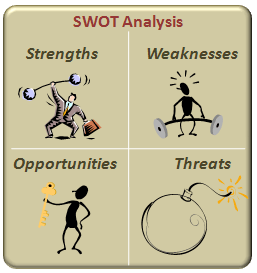Strategy is an integrated explanation of how an organization is going to guide its performance into the future.
In Part IV of “What is Strategy?” we put
everything together. You have chosen
your future with your Vision & Strategic Goals, and you have discerned your
SWOTs. Your Strategy answers the
question “How do we get from there (your Current Reality) to here (your Ideal
Future).”
Here is how you answer that question.
While looking at your goals, take each SWOT item
by item. Ask “What Strategic Action can
we take regarding this SWOT to move us toward our goals?”
For each Strength, ask “What Strategic Action can
we take to Leverage this Strength and move us toward the goals.
For each Weakness, ask “What Strategic Action can
we take to Fortify this Weakness and move us toward the goals.
For each Opportunity, ask “What Strategic Action
can we take to Seize this Opportunity and move us toward the goals.
For each Threat, ask “What Strategic Action can we
take to Block this Threat and move us toward the goals.
You are now entering the most creative part of the strategy
development process. Crafting the
Strategy requires you to look at your lists of Strategic Actions to discern which
ones are most important, and which you need to take early on. You will realize that some Strategic Actions
are actually more “strategic” than others.
You need to figure out which Strategic Actions will really move you
forward most effectively.
Look for connections between the Strategic Actions
and figure out how the sequencing will flow from one to another. As in chess, every action you take affects
the whole board. You need to weave these
various Strategic Actions together to identify your most important Strategic
Themes that result in your Strategy Narrative.
A Strategy Narrative is an explanation – or story – of how you are going
to Leverage your Strengths, Fortify your Weaknesses, Seize your Opportunities,
and Block your Threats to move you forward.
If we were sitting in your office I could work
through some examples with you to show you more clearly how this works. But this is the best I can do in a blog! There are more examples in the Mission Impact book, of course, and
there is an example in my Breakthrough Strategy Workbook which you can download
from my web site at no cost.
If you follow the process in these four recent blogs
then you can craft a Strategy that makes a Breakthrough Impact in the
difference you make for others. Good luck!
For more
ideas on how you can lead breakthroughs in your organization, follow this blog
and check out my web site at www.SheehanNonprofitConsulting.com You will find free resources you can
download, including a Breakthrough Strategy Workbook that you can download at
no cost. You can also check out my book,
Mission Impact: Breakthrough
Strategies for Nonprofits, and buy it if
you are interested. And you can follow Sheehan
Nonprofit Consulting on Facebook.


